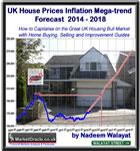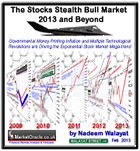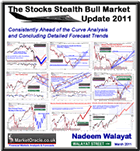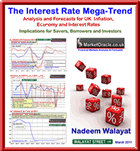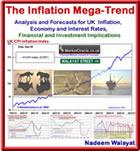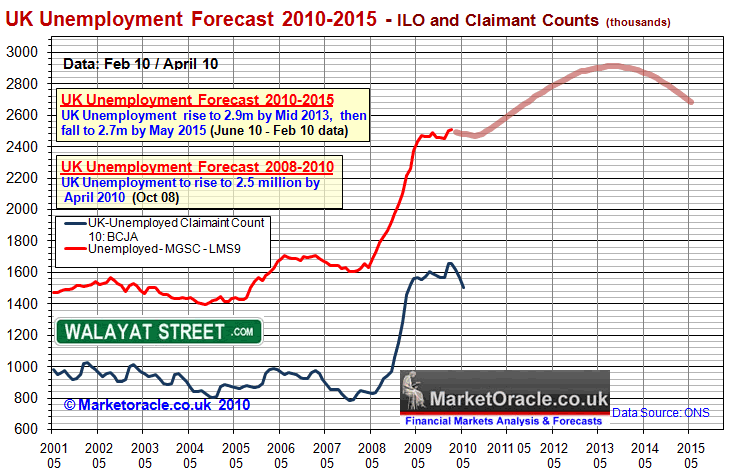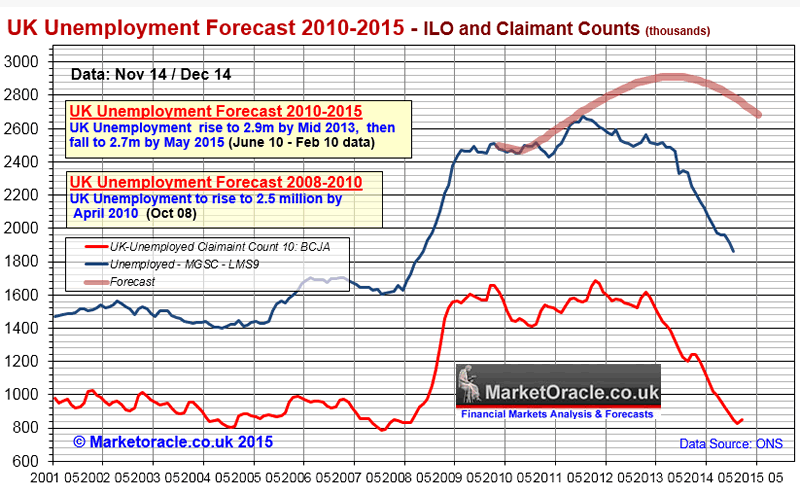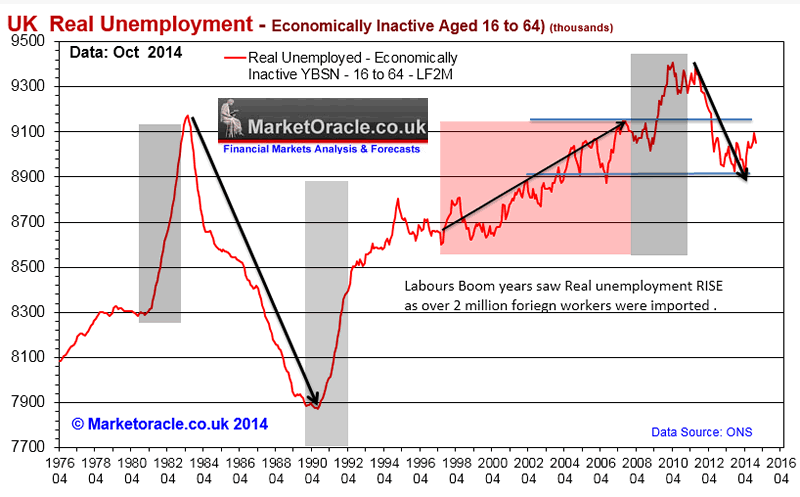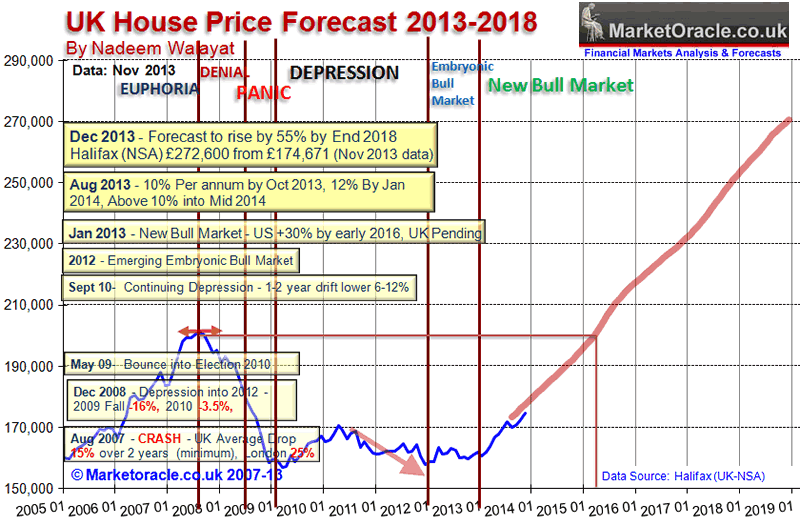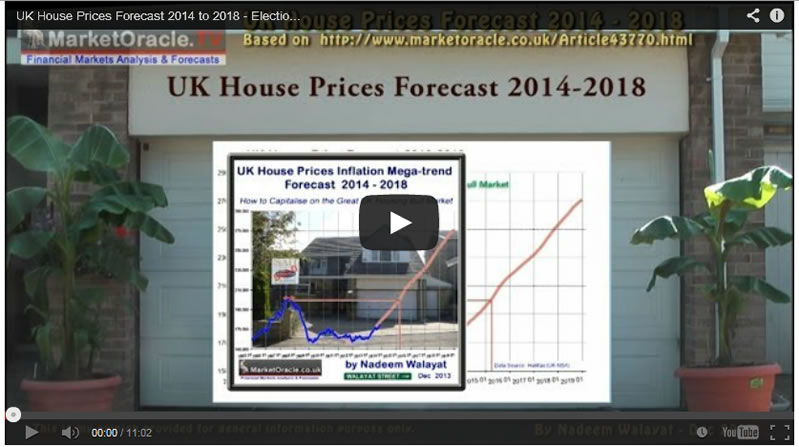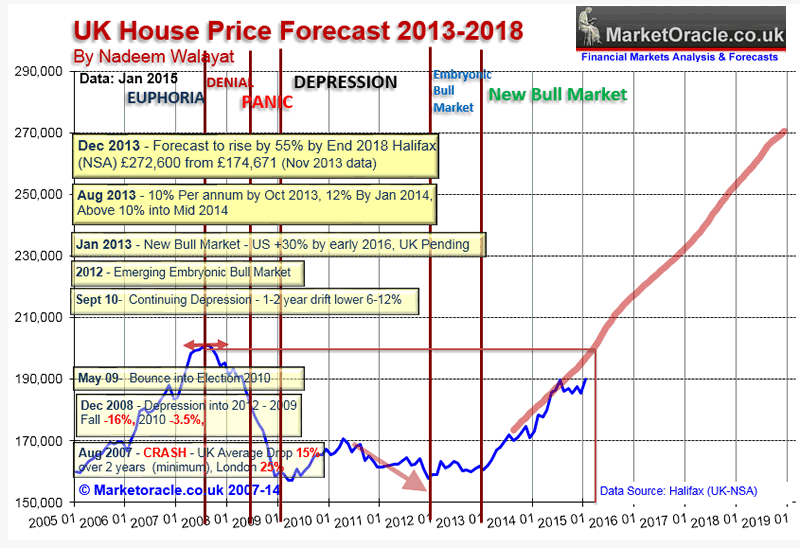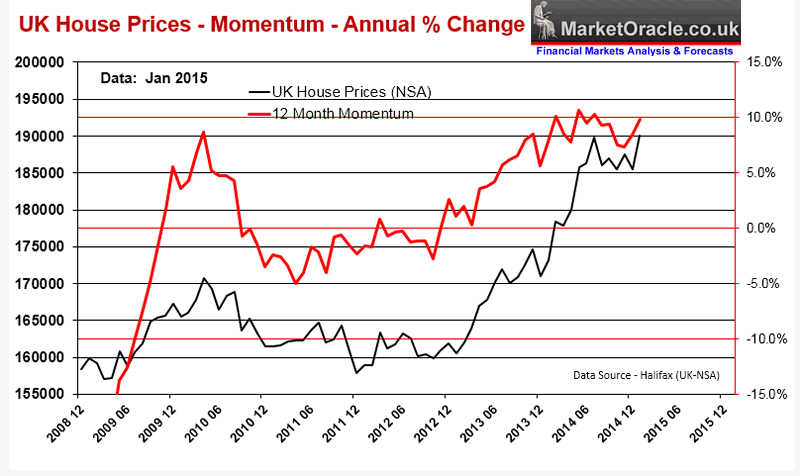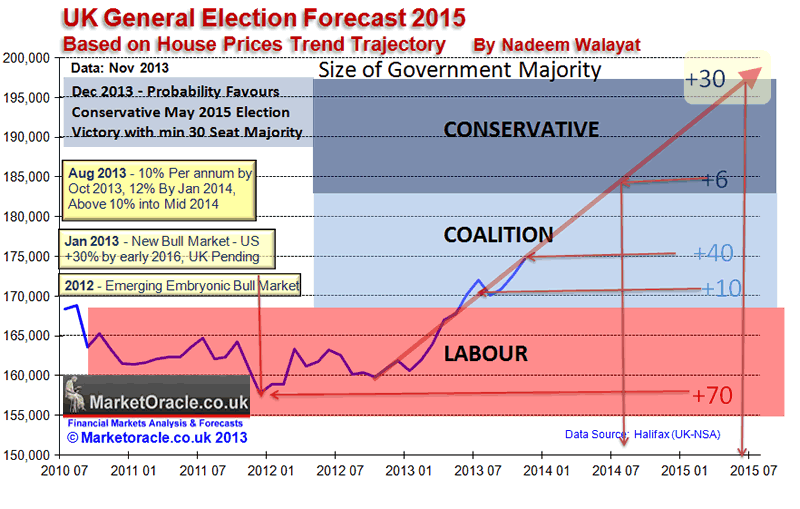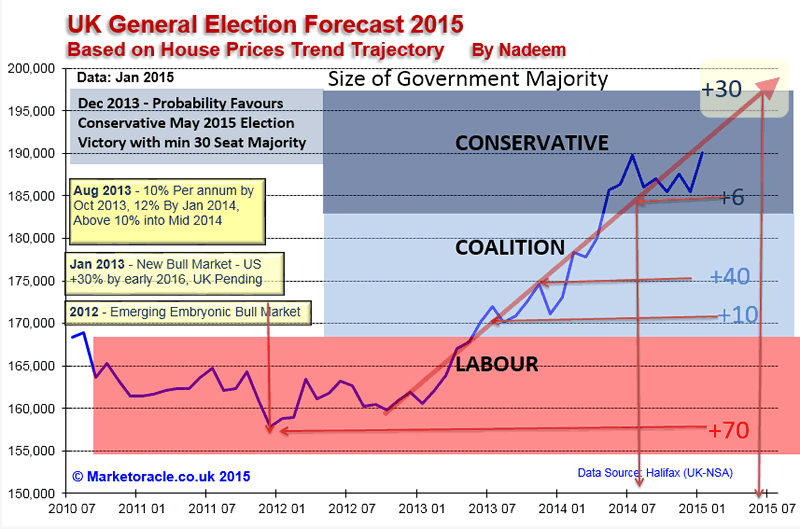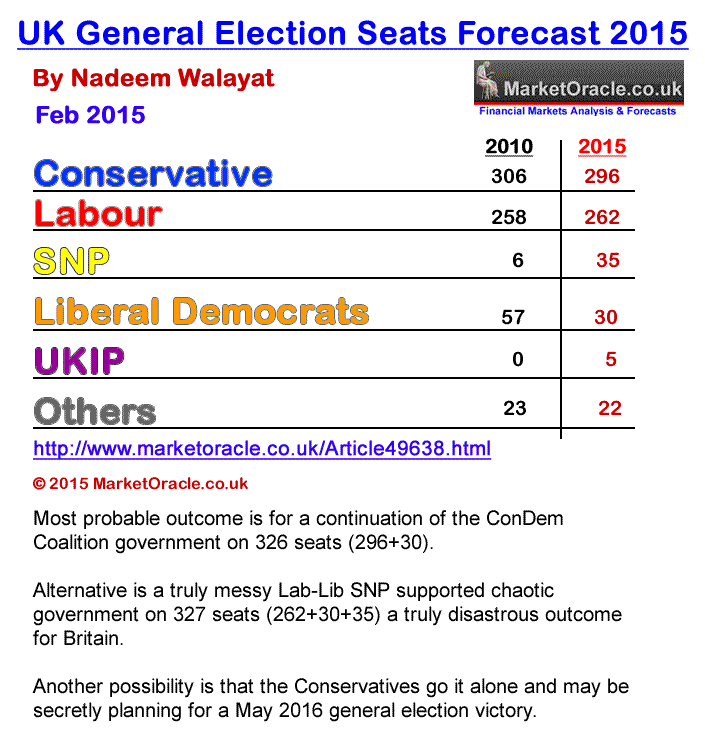UK General Election 2015 Seats Forecast - Who Will Win?
News_Letter / UK General Election May 18, 2015 - 02:38 PM GMTBy: NewsLetter
 The Market Oracle Newsletter Feb 28th, 2015
The Market Oracle Newsletter Feb 28th, 2015
Issue # 5 Vol. 9
UK General Election 2015 Seats Forecast - Who Will Win?
Dear Reader, This analysis directly continues from my preceding newsletter (Part 1) that forecast the probable seats for the UK's minor parties, which can also be accessed directly at the Market Oracle website (UK General Election 2015 - Forecasting Seats for SNP, LIb-Dems, UKIP and Others) This newsletter (Part 2) concludes by forecasting the probable seats for the Labour and Conservative parties, and which is most likely to form the next government. UK Political Party Funding Suggests Another ConLib General Election Outcome 2015 A recently published report by the Electoral Commission details fund raising by all of the major political parties for 2014, and allowing for expectations for a similar trend into the May 2015 general election means that significant differences in the funding of major parties election campaigns could result in a significant impact in this years too close to call probable hung parliament election result. The following table shows the total fund raising by each of the major parties for 2014 then extrapolated total into the end of April 2015.
(£1000's, includes approx 15% of public funding) It should not come as any surprise that the Conservatives top the table at £38.8 million (eventual total likely to be higher due to more big donors), with Labour second on £35.1 million. However, of surprise to many will be that the Lib Dems raised more then double the far more vocal and visible UKIP with the Greens lost in the wilderness where funding is concerned. That just leaves the SNP which is a special case because their fund raising included for last Septembers independence referendum and election spending is concentrated on just 59 seats rather than spread out across several hundred seats which means that the impact of the funds is far greater than the amount raised as their immediate competition, Labour will likely not be able commit to anywhere near the SNP's concentration towards fighting for Scottish seats, and in fact sucks Labour funds away from fighting English seats. So whilst the fund raising table percentages will obviously NOT directly converting into the number of seats won, nevertheless suggests that contrary to current opinion poll projections that favour Labour, instead the Conservatives look set to become the largest party with Labour forced to funnel resources into a losing battle with the SNP so implies will do much worse than expected and the problem for UKIP and Greens is their lack of critical mass i.e. their vote and funding will be spread too thinly which suggests that the Liberal Democrats will do much better than most are expecting today. Another point to consider is the borrowing capacity of the parties, i.e. how much debt do they already have outstanding that would limit future borrowing. The following table lists outstanding debt as of 31st December 2014.
(£1000's) Which again suggests that the Labour party is under immense financial pressures and unlikely to do as well as many expect. Whilst the Conservatives have the capacity to borrow several millions over the next few months to ramp up their election prospects and secure a handful of additional seats. So the only clear winner where this analysis is concerned are the SNP and at huge cost to Labour. Also that another hung parliament appears certain with a well over 90% probability, though the Conservatives by far look set to be the largest party and that the Lib Dems are likely to do better than most expect so we could be in for another ConLib government. UK Unemployment Plunge Conservative Election Boost UK unemployment falls to its lowest level for 6 years as statistics for the 3 months to December 2014 register a drop of 97,000 claimants to 1.86 million, standing at 5.7% of the workforce, and down nearly 1/2 million on a year ago that illustrates a continuing strong trend in the reduction of domestic unemployment that is set against approx 700,000 jobs created. The difference being that these jobs have gone to migrant workers from firstly Eastern Europe and then the bankrupting PIIGS nations with Spain, Portugal and Greece that have lost many of their brightest to the likes of Britain's NHS, so if your puzzled by the origins of your accented NHS consultant then you may find that they are probably Greek. Falling unemployment puts upwards pressure on wages that are now rising at 2.1% per annum, well above both official rates of inflation at CPI 0.3% and RPI 1.6%, perfectly times to coincide with the run up to the General election that follows sub-inflation or even falling wages for the past 5 years. My long standing forecast as of 4.5 years ago was for UK unemployment to trend higher towards a peak of 2.9 million by mid 2013 before trending lower into the May 2015 general election as I expected 70% of the new jobs created under the Coalition government to go to migrant workers as they continued to displace British workers. 01 Jul 2010 - UK Unemployment Forecast 2010 to 2015 Final conclusion - UK unemployment looks set to gradually rise to a peak of just over 2.9 million by mid 2013 before stabilising and starting to decline into a May 2015 General Election of just below 2.7 million against the governments forecast for UK unemployment to fall to 2 million by 2015 (OFBR - Peak at 8.1% this year before falling to 6.1%). The benefit claimant count can also be expected to rise, though is much more difficult to forecast as it is far easier for the government to manage claimant numbers by moving recipients onto other benefits, OFBR forecast a claimant count of 1.17 million by May 2015.
The following updated graph illustrates what has subsequently transpired in that UK unemployment did track my forecast for the first two years before starting to show significant divergence that on face value was a sign of relative economic strength but instead reflects the dual impact of the Coalition government stealthy abandoning the policies of economic austerity as evidenced by expansion of the budget deficit against forecast expectations. Something that both Labour and the Coalition government were happy to under play the significance of as both parties are invested in promoting the impacts of economic austerity. That and the trend for falling wages which encouraged employers to retain / employ workers on significantly less pay.
The positive UK unemployment trend has been further encouraged through a whole host of schemes such as the Bank of England's funding for lending scheme primarily for small businesses, full time workers converted to part time workers, and 1.1 million more self employed than there were in 2008, and that more than 1.2 million workers are now contracted under zero hours (up from 150,000 in 2010) that amount to a pools of virtual slave labour, workers who tend not to know if they will be working the following day until they receive a phone all or more usually the case a text message the evening before, and even then may find themselves rejected on arrival at work if the quota for workers has been fulfilled for that days shift work, or that their shift will end early on completion of the order, hence less pay as workers are only paid for hours actually worked. Real Unemployment is 5.5 Million Whilst the headline UK Unemployment rate peak of 2.7 million at 8.5% of the workforce is remarkably low when one compares it against past milder recessions had seen UK unemployment peak at much higher levels i.e. in the 1980's at 12% and in 1990 at 10.8%, therefore on face value the Labour government and then Coalition appeared to have achieved a minor miracle by UK unemployment peaking at only 8.5% amidst the worst recession since the Great Depression, which in reality was an 6 year economic depression. However, I have long questioned the accuracy and validity of the official unemployment data which over several decades and much manipulation by successive governments has been tweaked many hundreds of times to under report true unemployment for political purposes. Current official unemployment stands at 1.86 million which is set against the total recorded as economically inactive of working age that stands at over 9 million which illustrates the true extent of failure of the last Labour government to manage the potential of the work force during the boom years as illustrated by the fact that 80% of the 2.1 million jobs created under Labour went to foreign workers and therefore did nothing to address the true level of UK unemployment that contained a hidden ticking social security financing time bomb that we have seen explode as an extra £40 billion annual budget deficit.
During the Conservative boom cycle, real unemployment fell from the 1983 crisis peak. However the same did not take place following the early 1990's recession where real unemployment failed to not only fall but steadily rose under Labours boom years as the benefits culture took hold as over 1 million foreign workers performed the jobs that unemployed Britain's were not prepared to do as they were far more comfortable living off tax payers as vested interests in Labours benefits for life culture, thus Labour engineered an extra 2 million positive voter balance i.e. 1 million more benefit claimants coupled with 1 million low paid immigrant workers that continued to increase long after the boom had ended. Whilst not all of the 9 million economically inactive are capable of seeking work, however the figure does imply that at least 4 million of the 9 million form the core of the what we all knows as the benefits culture i.e. the could work but won't work. Therefore the 4 million not counted in official unemployment numbers that choose not to work but instead prefer to rely on tax payer funded benefits added to the official 1.86 million unemployed results in a total UK unemployment count of 5.9 million. Which is more in line with the recession experience of other similarly in-debted and structured European countries. The Conservative led coalition has only been marginally successful in dismantling Labours benefits for life culture, as clearly the fall in real unemployment is nowhere on the scale of that which occurred following the early 1980's recession, when real unemployment was reduced by 1.2 million against just 300,000 during the past few years, implying that the Coalition has so far only done half the job of unraveling Labours pool of vested interest benefit claimants. The key message that this graph sends out is that no matter what propaganda Labour politicians spout their actions in government are always to increase the number of real unemployed because most of whom would be expected to vote Labour just as took place during the Blair boom years. Implications for General Election Result Implications are for a further 100,000 reduction in headline unemployment number in the run up to election day and including effect of voting spouses and family members will likely result in at least 100,000 voters more predisposed to vote for the Conservatives, which whilst not a huge number of voters nevertheless will be enough to tip a handful of marginal seats in the Conservatives favour, and further illustrates in microcosm what is taking place right across Britain in terms of improving economic activity such as wage inflation, which means that today's opinion polls that tend to put the Tories and Labour neck and neck on about 270-280 MP's each are UNDER estimating the eventual number of seats that the Conservatives will actually succeed in winning. UK House Prices Trend 2015 and the May General Election For Britain the most critical economic driver, far beyond interest rates, inflation, or even unemployment is the trend in average house prices for the fundamental reason that positive housing market SENTIMENT IS that which makes the all difference between the UK economy being in recession or in an common boom, as you don't tend to get one without the other. Which any government of the day fully realises and why the Coalition government has literally bent over backwards to first ignite and then to target maintaining a house prices bull market right into the May 2015 General Election through a myriad of tax payer funded schemes such as ZERO interest rates, the Help to Buy Scheme, Stamp duty cut, today's start of a 20% house purchase discount scheme and a continuous flood of liquidity forcing savers to spend or invest depreciating value of bank deposits into primarily bricks and mortar as I have covered at length for several years - 19 Aug 2013 - UK House Prices Bull Market Soaring Momentum What Academics and Journalists Will Never Understand About Markets In having immersed by myself in the markets for 30 years now, I know that what many academics tend to take for granted rarely matches reality. Whilst I covered many aspects of trading markets in my last ebook (Stocks Stealth Bull Market 2013 and Beyond - Free Download). However in terms of economic trends what academics will always fail to grasp is that markets are NOT driven by fundamentals but by SENTIMENT and it is SENTIMENT that CREATES the fundamentals! Which is why the academic economists rarely have any real clue as to what is going in the markets because they are nearly always looking in the WRONG direction i.e. they are looking at the CAUSE rather than the EFFECT, as in reality it is the EFFECT that makes itself manifest in the price charts long before the CAUSE appears in the economic data that academics focus upon, which is why the SAME economic data can and is used by economists and pseudo-economist (journalists) such as that which we see on TV news shows to explain EITHER price rises OR falls. You can only know the markets IF you TRADE the markets! The pseudo and academics economists will never get you on the right side of trends years ahead of the herd, in fact most press media commentators will be some of the LAST people to jump onboard trends, usually just before they end! Momentum Drives Housing Market Sentiment and Economic Growth As house price rises continue to accelerate, many people sat on the sidelines waiting for prices to fall or even crash will realise that it is just not going to happen, and in their despair at the relentless accelerating trend of rising prices, in increasing numbers will feel no choice but to jump onboard the housing bull market as a they see the houses they have been viewing sold and asking prices trending ever higher. As house prices rise, home owners see the value of their houses rise £x thousands per month, in many cases by more than their salaries, this will encourage many to borrow and spend more, and save less which will meet the governments primary objective for inflating the economy by means of the housing market. Everyone will be playing the game of how much has my house value increased by, a quick analysis of my own housing portfolio (based in Zoopla estimates) shows a 5.5% increase in housing wealth over just the past 6 months! Does this make me feel richer, more willing to spend? Well, being only human, YES it does! UK House Prices 5 Year Forecast It is now 14 months since excerpted analysis and the concluding 5 year trend forecast from the then forthcoming UK Housing Market ebook was published as excerpted below- UK House Prices Forecast 2014 to 2018 - Conclusion This forecast is based on the non seasonally adjusted Halifax House prices index that I have been tracking for over 25 years. The current house prices index for November 2013 is 174,671, with the starting point for the house prices forecast being my interim forecast as of July 2013 and its existing trend forecast into Mid 2014 of 187,000. Therefore this house prices forecast seeks to extend the existing forecast from Mid 2014 into the end of 2018 i.e. for 5 full years forward. My concluding UK house prices forecast is for the Halifax NSA house prices index to target a trend to an average price of £270,600 by the end of 2018 which represents a 55% price rise on the most recent Halifax house prices data £174,671, that will make the the great bear market of 2008-2009 appear as a mere blip on the charts as the following forecast trend trajectory chart illustrates:
Additionally, a video version of excerpts of the forecast was posted during early January 2014 - Current State of the UK House Prices Forecast The updated Halifax average house prices (NSA) graph to Jan 2015 of £190,113 basically shows that the UK housing bull market paused from August to December 2014 before resuming its bull run in January. House prices are currently showing a deviation of 3.3% against the forecast trend trajectory. In terms of the long-term trend forecast for a 55% rise in in average UK house prices by the end of 2018, if the current deviation continued to persist then this would result in an 15% reduction in the forecast outcome to approx a 40% rise by the end of 2018.
UK House Prices Momentum into Election 2015 The following graph further illustrates the fall in momentum during the second half of 2014 and the recent surge higher back to 10% as UK house prices look set to soar to an annual inflation rate well above 10% per annum, timed to just reach their peak during May 2015 at probably around 12%, though unlikely to accelerate any higher due to weakness in house prices in the South East.
Thereafter we can expect a similar sharp slowdown to probably a greater extent than that of 2014. In fact the momentum trend is likely to be very similar to Labours 2010 house prices mini-election boom that I had started to warn to expect from mid 2009. Though at this point I am not expecting a similar post election collapse to -5% as that was as a consequence of Labour going for broke on a near £160 billion annual deficit debt printing binge. Implication for Sellers In my opinion property sellers have a golden window into Summer 2015 to maximise the selling price of their homes. So if your thinking of putting your home on the market then the time to act is NOW! Even a few weeks delay could make tens of thousands of pounds difference in outcome. We'll to be blunt you have left it a bit late, for I started warning of the embryonic beginnings for a multiyear bull market in 2012! That gave birth to the bull market proper of 2013 where the consolidation of late 2014 allowed for some respite for buyers but now momentum once more looks set to soar into the May 2015 election. Therefore it maybe better to await a post election correction than attempt to jump onto a galloping housing bull right now. Though do remember my forecast for a FIVE YEAR bull market into the END of 2018, so don't take any post election weakness to once more sit on your hands and wait for house prices to continuing weakening towards your fantasy price level because they won't, so do understand that post election weakness in UK house prices will be TEMPORARY! Of course this analysis is focused on AVERAGE house prices, as there will be a great deal of regional variations in trend where currently the closer one gets to London the weaker house prices will tend to be, and even negative, thus giving those buyers the upper hand. WARNING - Especially STEER CLEAR of FLATS! As my warning of 2014 continues into 2015. So if your thinking of buying in london then buy a HOUSE and NOT a FLAT! And finally not forgetting Scotland's oil price collapse bust that is hitting cities such as Aberdeen hard. Also See my UK Housing Market ebook (FREE DOWNLOAD) for a whole host of buying, selling and improvement guides. Implications for the General Election Clearly the house prices driven economic mini-boom is timed to PEAK during May 2015 at approx 12% per year, to just exceed the 10% Labour mini-boom into the May 2010 general election. Which therefore implies that the prospects for the Conservatives and to a far lesser extent the Liberal Democrats should continue to improve right upto polling day. Although 12% will not be on par with the landslide generating booms of the noughties of over 20%. So house prices are suggesting a very similar election result for the Conservatives to that of 2010. My long standing General Election seats / house prices trend trajectory graph paints the following picture for a likely probable Conservative general election victory. 16 Dec 2013 - UK General Election Forecast 2015, Who Will Win, Coalition, Conservative or Labour?
A May 2015 general election at an average house price inflation rate of 8.5% would result in a Conservative overall majority of about 30 seats. Therefore this is my minimum expectation as I expect UK house prices to start to average 10% per annum from the beginning of 2014. The updated election seats trend graph illustrates that the Conservatives are virtually ON TRACK to achieve the forecast outcome for an outright election victory on a majority of about 30 seats which NO ONE, and I mean no serious commentators / analysts is advocating the probability of today.
Therefore as I mentioned near the start of this analysis one needs to keep all possibilities in mind and not to completely discount what appears to be inconceivable at a particular point in time i.e. for the Conservatives to win an outright majority. Formulating a Forecast Conclusion Having concluded that all of the smaller parties will take 92 seats away from the total of 650. Which leaves 558 to be divided between the Conservatives and Labour which on the most recent opinion polling and seat projections such as by May2015.com, would convert into Labour on approx 281 seats and the Conservatives on approx 277. However, as this unfolding analysis has illustrated that the opinion polls are grossly under-estimating the number of seats that the Conservatives will actually achieve, where there is even a chance for the Conservatives to surprise all (including myself) and achieve an outright election victory! The reasons for why will only become apparent with the benefit of hindsight but I can guess that there are many millions of voters out there whilst refusing to back the Conservatives today, nevertheless presented with a stark choice on election day of between the ConDem coalition having demonstrated that they are competent at managing the economy, against the risk of Labour screwing up the economy once more, or worse tipping the UK into financial armageddon Greece style, which is highly probable given their probable SNP coalition partners demands for Scotland this, that and the other and screw the consequences for the rest of the UK. Then for many million of wavering voters the only logical decision they can make is to vote for the Conservatives whether they support the Conservatives or not. However, whilst a Conservative win is possible, I do not see it as probable, instead I see a hung parliament with the Conservatives as the largest party as the far more probable outcome and even there I find it difficult to conclude that with the Conservatives facing a UKIP surge will be able to retain their current tally of 302 MP's as I expect at least 3 will be lost to UKIP and many more lost to Labour, against which at least a handful will likely be gained from the Lib Dems. Which therefore suggests that the Tories will achieve a seat total in the 290's. UK General Election May 2015 Forecast Conclusion My forecast conclusion is for the Conservatives to win 296 seats at the May 7th general election, Labour 2nd on 262 seats, with the full seats per political party breakdown as follows:
Therefore the most probable outcome is for a continuation of the ConDem Coalition government on 326 seats (296+30) where any shortfall would likely find support from the DUP's 8 seats. The alternative is for a truly messy Lab-Lib SNP supported chaotic government on 327 seats (262+30+35) which in my opinion would be a truly disastrous outcome for Britain, nearly as bad as if Scotland had voted for independence last September. Another possibility is that should the Conservatives do better than forecast i.e. secure over 300 seats but still fail to win an overall majority, then they may chose to go it alone with the plan to work towards winning a May 2016 general election. The bottom line is that the opinion polls do not reflect how people will actually vote on May 7th when they are faced with a stark choice of steady as she goes ConDem government or take a huge gamble on Ed Milliband's Labour party. So in my opinion several millions of voters will chose to play it safe with ConDem which thus is the most probable outcome. Ensure you are subscribed to my always FREE newsletter for in-depth analysis and detailed trend forecasts delivered direct to your email in box. Source and Comments: http://www.marketoracle.co.uk/Article49638.html Your postal ballot voting analyst. By Nadeem Walayat Copyright © 2005-2015 Marketoracle.co.uk (Market Oracle Ltd). All rights reserved. Nadeem Walayat has over 25 years experience of trading derivatives, portfolio management and analysing the financial markets, including one of few who both anticipated and Beat the 1987 Crash. Nadeem's forward looking analysis focuses on UK inflation, economy, interest rates and housing market. He is the author of five ebook's in the The Inflation Mega-Trend and Stocks Stealth Bull Market series that can be downloaded for Free.
Disclaimer: The above is a matter of opinion provided for general information purposes only and is not intended as investment advice. Information and analysis above are derived from sources and utilising methods believed to be reliable, but we cannot accept responsibility for any trading losses you may incur as a result of this analysis. Individuals should consult with their personal financial advisors before engaging in any trading activities.
You're receiving this Email because you've registered with our website. How to Subscribe Click here to register and get our FREE Newsletter To access the Newsletter archive this link Forward a Message to Someone [FORWARD] To update your preferences [PREFERENCES] How to Unsubscribe - [UNSUBSCRIBE]
The Market Oracle is a FREE Financial Markets Forecasting & Analysis Newsletter and online publication. |
||||||||||||||||||||||||||||||||||||||||||||||||||||||||||
© 2005-2022 http://www.MarketOracle.co.uk - The Market Oracle is a FREE Daily Financial Markets Analysis & Forecasting online publication.



